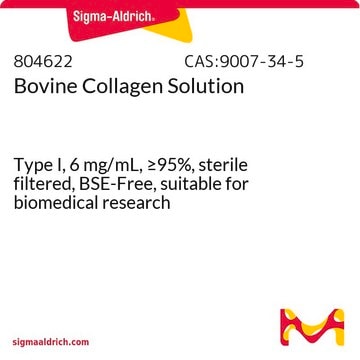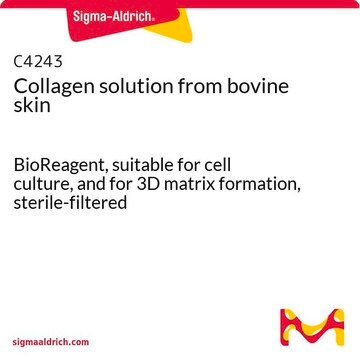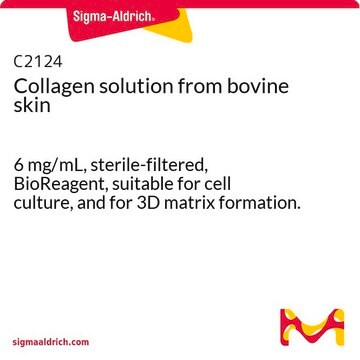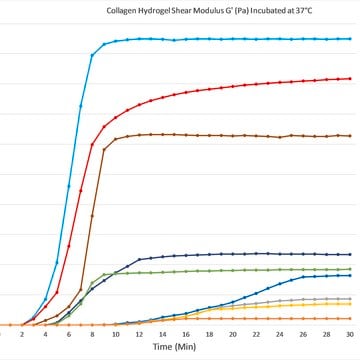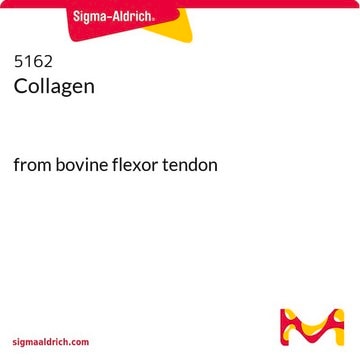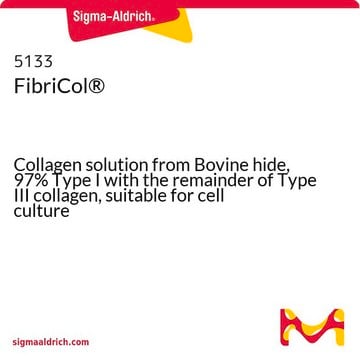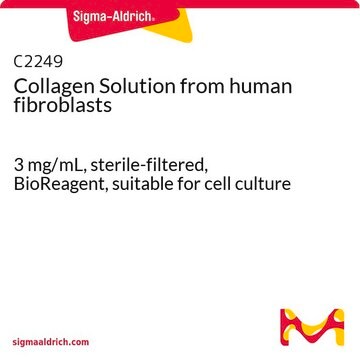804592
Bovine Collagen Solution
Type I, 3 mg/mL, ≥95%, sterile filtered, BSE-Free, suitable for biomedical research
Synonym(s):
Collagen I
Sign Into View Organizational & Contract Pricing
All Photos(1)
About This Item
Recommended Products
Assay
≥95%
form
liquid
concentration
3 mg/mL
shipped in
wet ice
storage temp.
2-8°C
Looking for similar products? Visit Product Comparison Guide
General description
- Highly purified bovine corium pepsin solubilized collagen, atelo collagen, in 0.01 N HCl, pH 2. Predominantly Type I collagen with approximately 5% Type III at 3 mg/ml.
- Sterile filtered.
- BSE-Free.
- ≥95% purity by SDS PAGE.
Bovine Collagen Solution can be used to form 3D structures for culturing or coating plastic labware for increased cell adhesion. It can form a gel at pH 7 and is ideal for 3D biomaterial scaffolds for cell culture, engineering tissue, and drug delivery.
Application
Forms a gel at pH 7 and is ideal for 3D biomaterial scaffolds for cell culture, engineering tissue, and drug delivery.
Legal Information
Product of Collagen Solutions.
Storage Class Code
12 - Non Combustible Liquids
WGK
nwg
Flash Point(F)
Not applicable
Flash Point(C)
Not applicable
Certificates of Analysis (COA)
Search for Certificates of Analysis (COA) by entering the products Lot/Batch Number. Lot and Batch Numbers can be found on a product’s label following the words ‘Lot’ or ‘Batch’.
Already Own This Product?
Find documentation for the products that you have recently purchased in the Document Library.
Customers Also Viewed
Wallace D, et al.
Advanced Drug Delivery Reviews, 55, 1631-1649 (2003)
Luo Z, et al.
Angewandte Chemie (International Edition in English), 50, 640-643 (2011)
Bareil RP, et al.
Materials, 3, 1863-1887 (2010)
Qun Zhang et al.
Stem cell research & therapy, 11(1), 407-407 (2020-09-20)
In recent years, significant progress has been made in developing highly complex tissue-engineered skin substitutes (TESSs) for wound healing. However, the lack of skin appendages, such as hair follicles and sweat glands, and the time required, are two major limitations
David Olagnier et al.
Nature communications, 11(1), 4938-4938 (2020-10-04)
Antiviral strategies to inhibit Severe Acute Respiratory Syndrome Coronavirus 2 (SARS-CoV2) and the pathogenic consequences of COVID-19 are urgently required. Here, we demonstrate that the NRF2 antioxidant gene expression pathway is suppressed in biopsies obtained from COVID-19 patients. Further, we
Our team of scientists has experience in all areas of research including Life Science, Material Science, Chemical Synthesis, Chromatography, Analytical and many others.
Contact Technical Service
